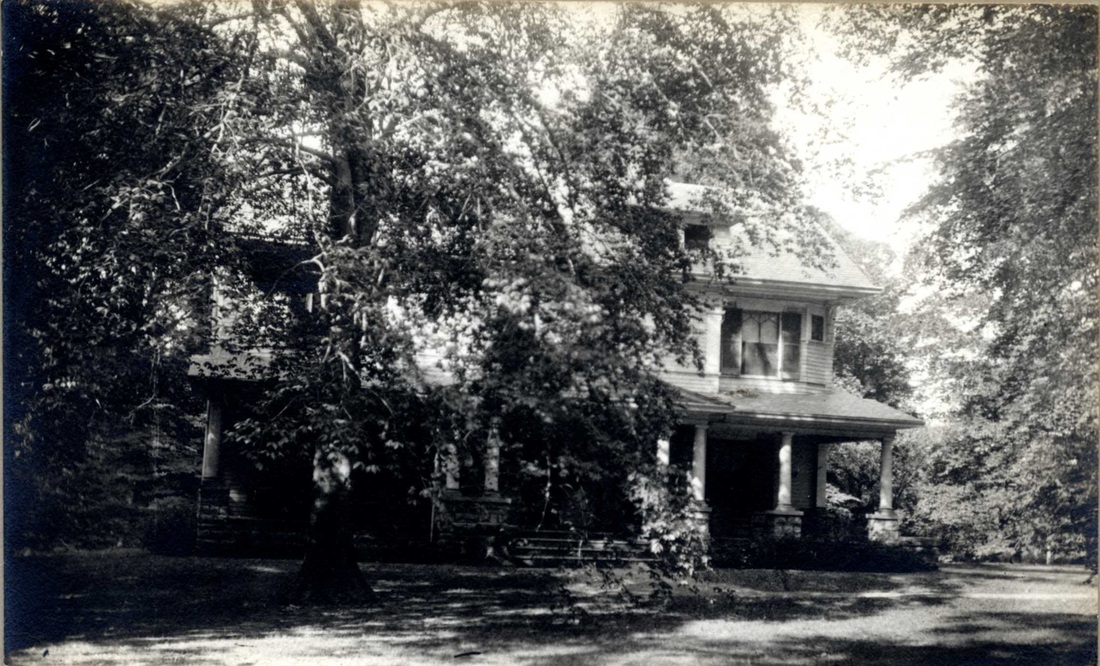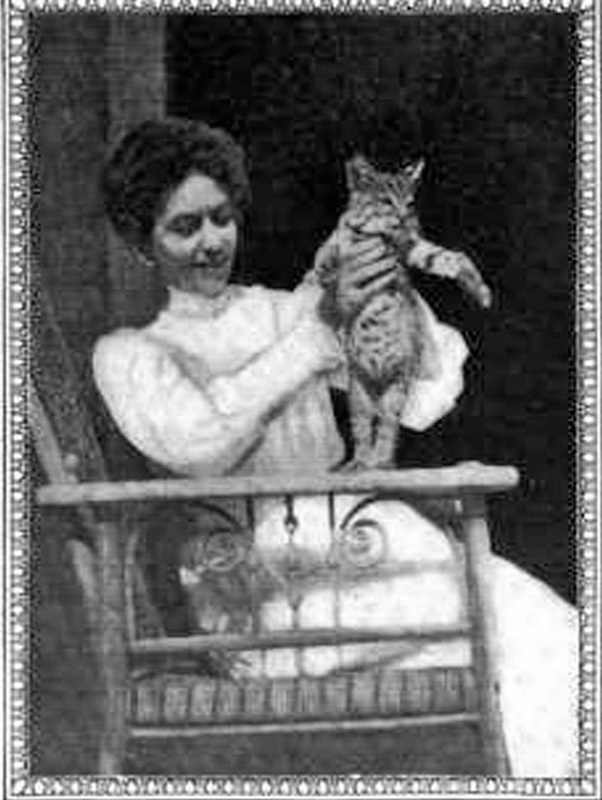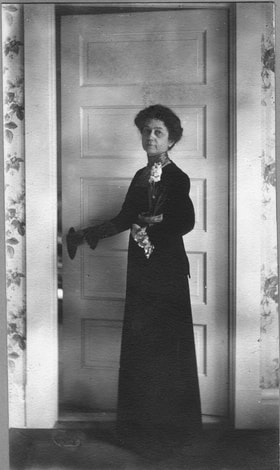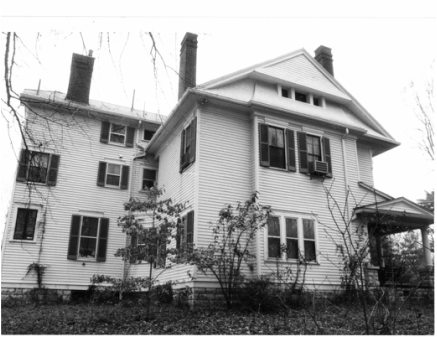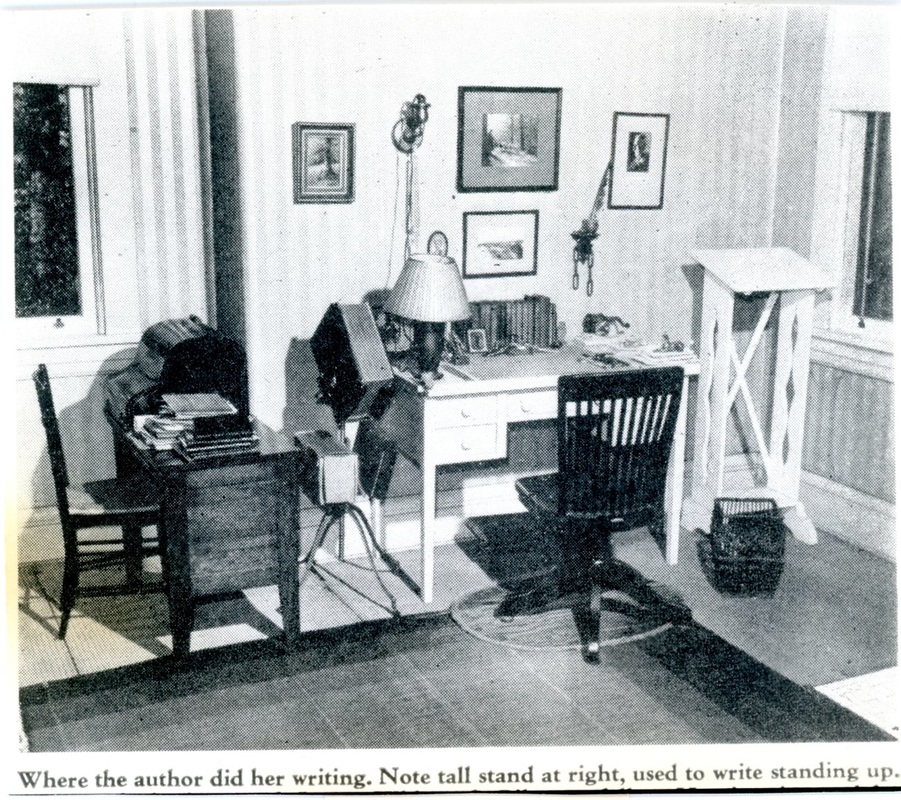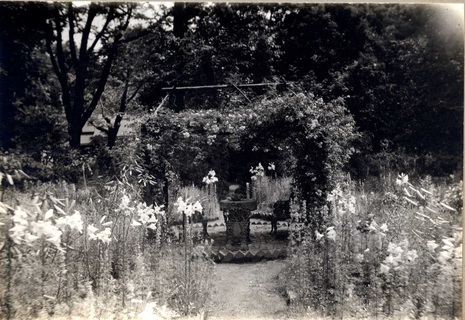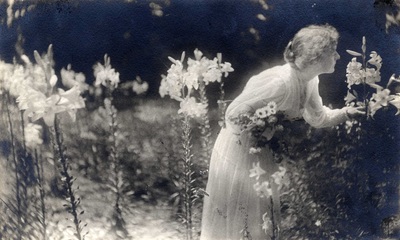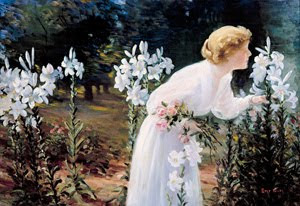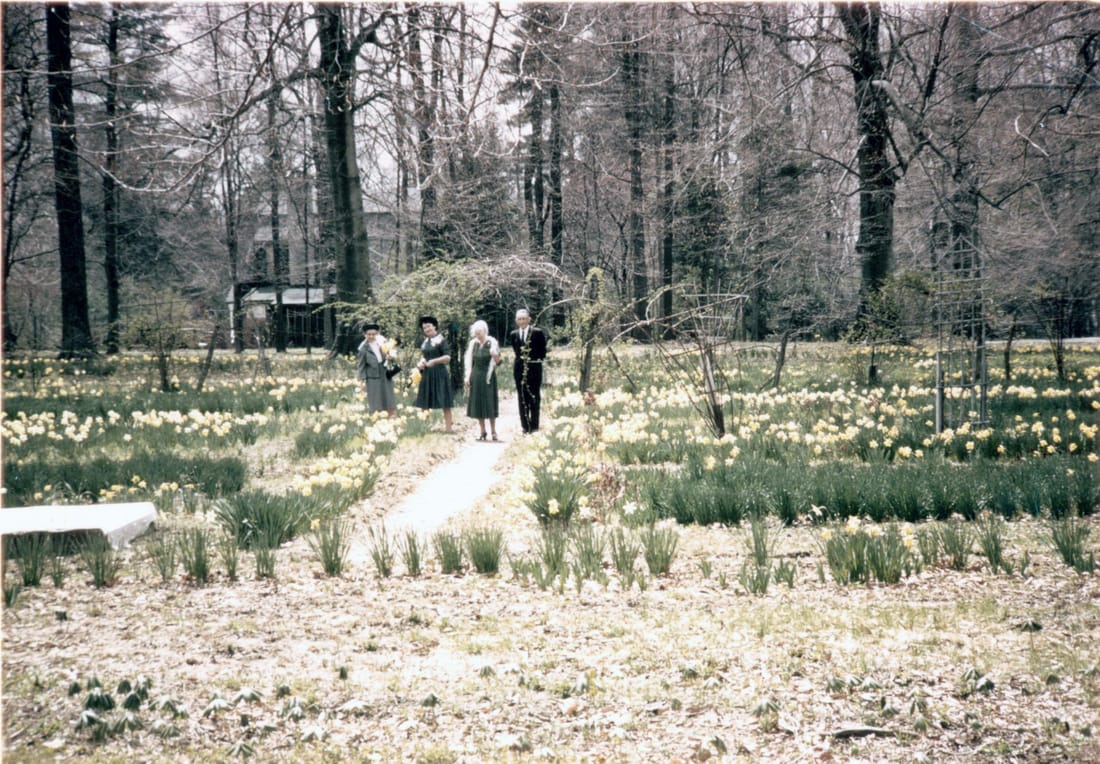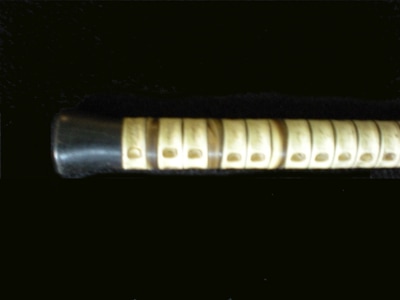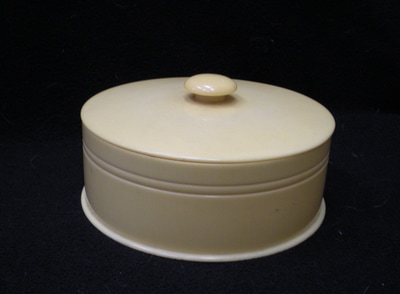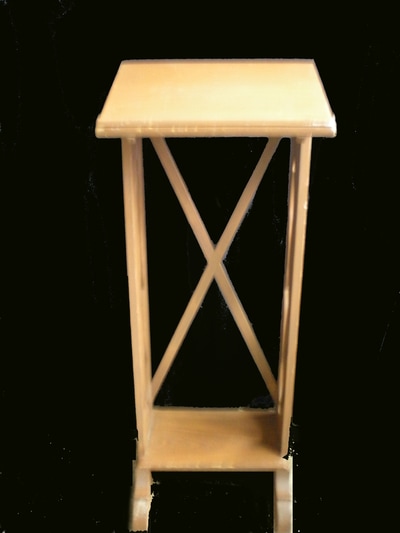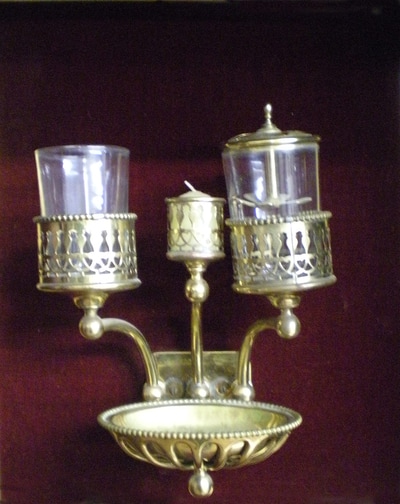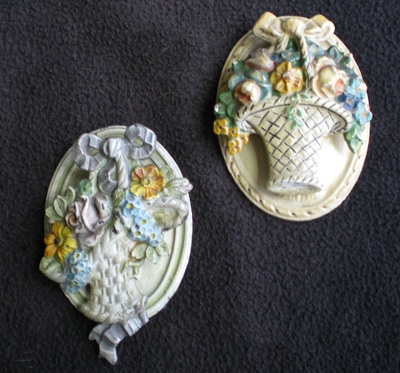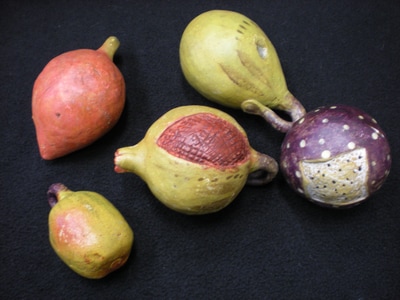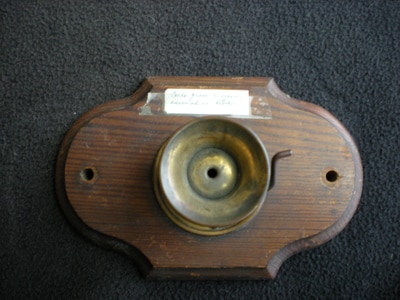The Beeches: The Lawton & Johnston Years
|
|
Although it’s hard to believe today, in the 1920s and 1930s, Pewee Valley was a major tourist attraction – so much so, in fact, that “Kentucky: A Guide to the Bluegrass State,” published by the University of Kentucky in 1939, included almost a full page about the “…quiet suburban village with attractive old homes on spacious lawns.”
What brought visitors here in droves—the record was 98 in a single day -- was The Beeches, and its famous owner, Annie Fellows Johnston, author of the “Little Colonel” stories. One pilgrim from Chicago had such a hard time finding the dwelling, which sits far back from tree-lined Central Avenue, that he took it upon himself to erect a neatly-lettered sign at the entrance: “The Beeches – Annie Fellows Johnston.” That sign saved her neighbors a lot of doorbell ringing from lost tourists! Annie Fellows Johnston lived at The Beeches from 1911 until her death in 1931. But for many years after – until her own death in 1966 -- artist Mary G. Johnston kept the house much as it was while Annie was alive and continued to welcome her stepmother’s many fans. |
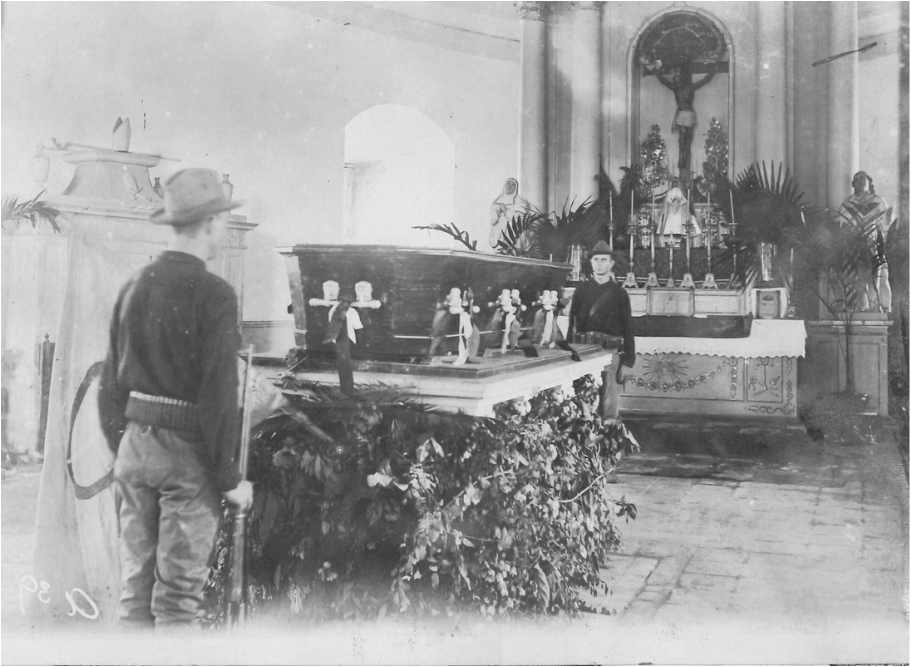
Henry Ware Lawton was career military and the only general killed in the Philippine-American War. The photo above shows his casket on display at San Mateo, before his body was shipped home for burial. Courtesy of Jonathan Noffke. Below, a photo from Fly's Gallery in Tombstone, Arizona. Lawton won widespread fame during the Indian Wars when he captured Geronimo.
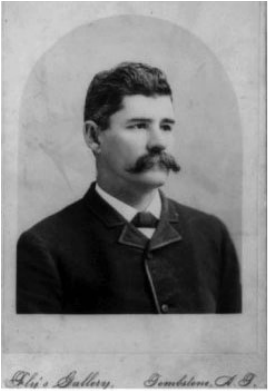
Annie Fellows Johnston wasn’t the first nationally-known personage to live at The Beeches. The house was built in 1902 by Mary “Mamie” Craig Lawton, after her husband, General Henry Ware Lawton, was killed on December 16, 1899 in San Mateo, Philippines during the Spanish American war.
His death left Mamie and her four children (son Manly and daughters Frances, Katherine and Allison) with no means of support and heavily in debt from a home they had built in Redlands, California. Mamie and the children had followed her husband wherever he served, from Ft. Huachuca, Arizona during the Indian Wars, where he captured Geronimo, to Washington, D.C.; Redlands, California; and finally to the Philippines. A national subscription was set up in the weeks following the popular hero’s death to support his widow and children. Large donations from politicians and businessmen as well as pennies from school children added up to $99,000 – the equivalent of $2.75 million today.
His death left Mamie and her four children (son Manly and daughters Frances, Katherine and Allison) with no means of support and heavily in debt from a home they had built in Redlands, California. Mamie and the children had followed her husband wherever he served, from Ft. Huachuca, Arizona during the Indian Wars, where he captured Geronimo, to Washington, D.C.; Redlands, California; and finally to the Philippines. A national subscription was set up in the weeks following the popular hero’s death to support his widow and children. Large donations from politicians and businessmen as well as pennies from school children added up to $99,000 – the equivalent of $2.75 million today.
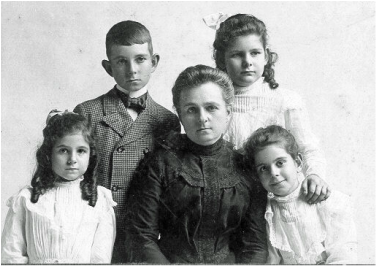 Mary Craig Lawton, wearing mourning clothes after Henry's death, with her four children. Bottom row: Louise, Mary and Katherine
Second row: Manly and Frances.
Mary Craig Lawton, wearing mourning clothes after Henry's death, with her four children. Bottom row: Louise, Mary and Katherine
Second row: Manly and Frances.
A letter she wrote thanking the public for their generosity appeared in newspapers across the U.S. The text below was published in the Desseret Evening News on Thursday, February 22, 1900.
Mrs. Lawton’s Acknowledgement.
Washington, Feb. 21 – Mrs. Lawton has made the following acknowledgement of the receipt of the home fund:
“Pewee Valley, Ky., Feb. 18, 1900: – Dear General Corbin: -- Such kindness as yours can never be repaid, and my heart is very full when I try to thank you. Words seem very poor at such a time. You will please believe that I do appreciate it and all my life will find comfort in the remembrance?
“The universal feeling which prompted such wonderful generosity from the Nation is so beautiful to me, and so dear, my gratitude is inexpressibly profound.
“It has relieved the one anxious thought Henry would have had and I do not know how to thank you or the Nation.
Believe me, with kind regards, very sincerely,
MARY C. LAWTON”
Mrs. Lawton’s Acknowledgement.
Washington, Feb. 21 – Mrs. Lawton has made the following acknowledgement of the receipt of the home fund:
“Pewee Valley, Ky., Feb. 18, 1900: – Dear General Corbin: -- Such kindness as yours can never be repaid, and my heart is very full when I try to thank you. Words seem very poor at such a time. You will please believe that I do appreciate it and all my life will find comfort in the remembrance?
“The universal feeling which prompted such wonderful generosity from the Nation is so beautiful to me, and so dear, my gratitude is inexpressibly profound.
“It has relieved the one anxious thought Henry would have had and I do not know how to thank you or the Nation.
Believe me, with kind regards, very sincerely,
MARY C. LAWTON”
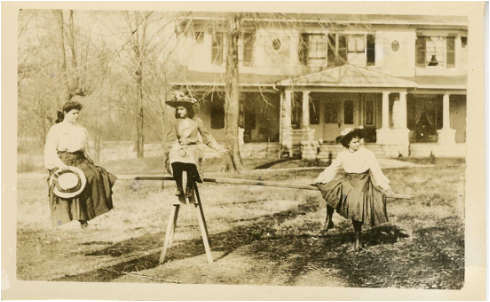 The three Lawton girls playing on a teeter totter in The Beeches' front yard. Courtesy Suzanne Schimpeler.
The three Lawton girls playing on a teeter totter in The Beeches' front yard. Courtesy Suzanne Schimpeler.
Mamie built her house in Pewee Valley, because most of her family lived there. Her mother, Annie Craig; sister, Fanny; and brothers Aleck, Merton and Harry lived across the street from The Beeches at Edgewood, Mamie’s childhood home and where her marriage to then-Captain Henry Lawton was solemnized.
Two doors down from Edgewood, in the house known as Woodside, lived her niece Alice Craig Peay Gatchel with her husband, Frank, and their two children, Frances and Billy. Another sister, Louise Craig Culbertson, lived with her husband, Samuel, and their two sons, William Stuart and Alexander Craig, in a mansion on “Millionaire’s Row” in Louisville – just an hour away by interurban trolley.
The August 18, 1901 St. Louis Dispatch reported that she purchased the Allan Hite property in Pewee Valley -- 12 unimproved acres -- for $4,000. Her building plans were announced in the February 6, 1902 Courier-Journal:
... Mrs. Henry Lawton, widow of Gen. Lawton, has had plans made for the handsome residence which she will build on a site facing the residence of her mother, Mrs. Craig. The house is to be one of the most elegant in Pewee. It will be built in the spring ...
Mamie retained the services of two different architects to design The Beeches. The first was Adolph Hallenberg, but the two parted ways when Hallenberg -- an 1867 graduate of the Massachusetts Institute of Technology (M.I.T.) -- came up with a plan that was way beyond her budget. He later sued and won, but received very little for his efforts, according to the April 21, 1903 Courier-Journal:
Adolph Hallenberg, the architect, secured a verdict of $10 against Mrs. Mary C. Lawton, widow of Gen. Lawton, in Judge Fields' court yesterday morning. The plaintiff brought suit for $250, which he alleged was due him on plans for a residence for Mrs. Lawton he drew up in September, 1901. He claimed that she agreed absolutely to take the plans. Mrs. Lawton's evidence, however, was to the effect that she had asked him to draw up plans for a residence that would not exceed $4,000, and that those he tendered her contemplated a greater outlay than that amount...
She evidently hired a second architect who was able to create a design that met her specifications; however, the identity of the architect is unknown.
Two doors down from Edgewood, in the house known as Woodside, lived her niece Alice Craig Peay Gatchel with her husband, Frank, and their two children, Frances and Billy. Another sister, Louise Craig Culbertson, lived with her husband, Samuel, and their two sons, William Stuart and Alexander Craig, in a mansion on “Millionaire’s Row” in Louisville – just an hour away by interurban trolley.
The August 18, 1901 St. Louis Dispatch reported that she purchased the Allan Hite property in Pewee Valley -- 12 unimproved acres -- for $4,000. Her building plans were announced in the February 6, 1902 Courier-Journal:
... Mrs. Henry Lawton, widow of Gen. Lawton, has had plans made for the handsome residence which she will build on a site facing the residence of her mother, Mrs. Craig. The house is to be one of the most elegant in Pewee. It will be built in the spring ...
Mamie retained the services of two different architects to design The Beeches. The first was Adolph Hallenberg, but the two parted ways when Hallenberg -- an 1867 graduate of the Massachusetts Institute of Technology (M.I.T.) -- came up with a plan that was way beyond her budget. He later sued and won, but received very little for his efforts, according to the April 21, 1903 Courier-Journal:
Adolph Hallenberg, the architect, secured a verdict of $10 against Mrs. Mary C. Lawton, widow of Gen. Lawton, in Judge Fields' court yesterday morning. The plaintiff brought suit for $250, which he alleged was due him on plans for a residence for Mrs. Lawton he drew up in September, 1901. He claimed that she agreed absolutely to take the plans. Mrs. Lawton's evidence, however, was to the effect that she had asked him to draw up plans for a residence that would not exceed $4,000, and that those he tendered her contemplated a greater outlay than that amount...
She evidently hired a second architect who was able to create a design that met her specifications; however, the identity of the architect is unknown.
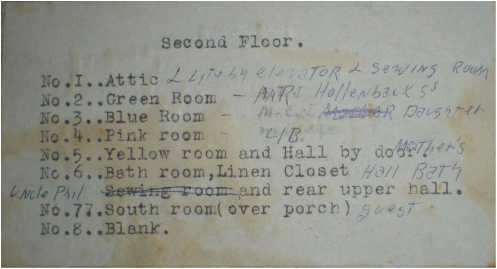
Most of the parties, tableaux, charades, dances, weddings and games that occurred at The Locust in the “Little Colonel” stories actually occurred at The Beeches, while the Lawtons were in residence. The Locust's different-colored bedrooms in the books -- green, blue, pink and yellow -- were also actually at The Beeches, as evidenced by the typed guide to The Beeches' circuits (right) still taped inside the second floor electrical box.
Hattie Cochran, the real-life girl who inspired the Little Colonel character, Lloyd Sherman, spent hours playing with the Lawton girls on the front porch.
Hattie Cochran, the real-life girl who inspired the Little Colonel character, Lloyd Sherman, spent hours playing with the Lawton girls on the front porch.
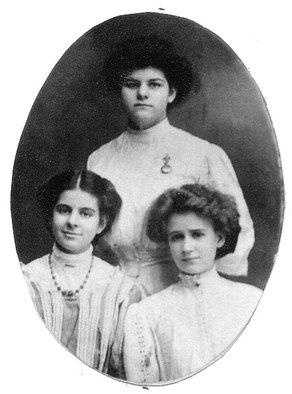 Top, Frances Lawton. Bottom, left to right, Catherine Lawton and Little Colonel Hattie Cochran. Evansville Courier, July 15, 1944.
Top, Frances Lawton. Bottom, left to right, Catherine Lawton and Little Colonel Hattie Cochran. Evansville Courier, July 15, 1944.
Annie Fellows Johnston met the Craig family in the late 1898, when she was renting The Gables. The Craigs eventually inspired 12 characters in the “Little Colonel” stories, starting with the publication of “Two Little Knights of Kentucky (Who Were the Little Colonel's Neighbors)” in 1899. Even after the novelist left Pewee Valley, journeying to New York, California, Arizona and Texas in search of a cure for her stepson John’s tuberculosis, she maintained a lively correspondence with Mamie Lawton and used details of the Lawton family’s lives in her books.
In 1910, John Johnston died of TB in Boerne, Texas. His stepmother and sister sold their Lone Star State home – dubbed Pen Acres by Annie, since she paid it with her pen – and returned to Pewee Valley. Around the same time, Mamie moved to Annapolis, to be closer to her daughter, Frances, who had married a lieutenant commander in the U.S. Navy. Mamie sold the house to Annie, who also purchased The Gables next door in 1913.
The move did not go quite as smoothly as planned, judging from a letter Mamie Lawton wrote to Annie on June 11, 1912 from Annapolis. Annie evidently bought furnishings and other items along with the house and all was not as agreed. Plus, Annie had contracted the mumps, foreshadowing, perhaps, her later battle with cancer of the salivary gland:
Dear “Cousin Annie,”
My apology for not attending to your request at once, is that it came at the beginning of “June Week,” which is the event of the year in Annapolis. My day began at seven each morning and ended at twelve, one, and three, as the case might be, and no rest for a minute. I feel tired out and dissipated yet. Frances and Elise left for the Happy Valley yesterday, and Catherine’s young man moving right in. He is to stop with us pending his application to the Adjutant General to enter the Army. So my hands are full. I don’t understand about the pillows unless Daphne and Maggie relieved me of them. I certainly had them and Maggie put them away. Those bolsters are big and made of best feathers. Jane Taylor is very good at making pillows and trustworthy. One of those bolsters in the attic will, I think, make three nice pillows. Let her make them the size you want, and I will write Frances to order some good ticking, the quantity will depend upon the size you want, of course. I am writing Frances so as to save you trouble. I can’t tell you how sorry I am about this, and the delay in getting settled. Gibson promised me faithfully to take the kitchen stove off, and Sarah was to clean up after him. Gibson said he could sell it. He also told me he had fixed that leak. I am sure I can give you a list of things you bought, but am afraid the individual price list is gone. I used a common scratch pad in making it out. Got Fanny to go over each article with me, and in some articles like garden tools, “bunched” them, putting them at half, third, and fourth of the original price. I find a list of the articles without the prices, and send it to you that you may at least know what belongs to you. The scratch pad list, I think, got all rubbed and worn, but I meant to keep it and thought I had. It must have blown off the table or been mistaken for trash. The enclosed was in my trunk. I am telling Frances to telephone or see you some afternoon about the pillows, and have Jane do them at once. I can’t tell you how sorry I am. I know what it means to you and only wish I could have stayed just long enough to see to these matters myself. I wonder if Mamie would let me know what colors you have chosen for each room and how they look, and how long the mumps delayed you. I have wished for you a thousand times since I got back. It is truly well worth seeing, and you could get so much out of it. I wish I could write as much as I want to say, but everything has accumulated during the last ten days, and there are oceans of things to do. Please let Jane make the pillows, only tell me the size you want. I am hoping, dear Cousin Annie that you and Mamie will find your home all you expect, and that it will be to you all it was to me. I love it, and it is such a comfort and pleasure to me to think of you there.
Love to you both.
Devotedly,
Mary C. Lawton
In 1910, John Johnston died of TB in Boerne, Texas. His stepmother and sister sold their Lone Star State home – dubbed Pen Acres by Annie, since she paid it with her pen – and returned to Pewee Valley. Around the same time, Mamie moved to Annapolis, to be closer to her daughter, Frances, who had married a lieutenant commander in the U.S. Navy. Mamie sold the house to Annie, who also purchased The Gables next door in 1913.
The move did not go quite as smoothly as planned, judging from a letter Mamie Lawton wrote to Annie on June 11, 1912 from Annapolis. Annie evidently bought furnishings and other items along with the house and all was not as agreed. Plus, Annie had contracted the mumps, foreshadowing, perhaps, her later battle with cancer of the salivary gland:
Dear “Cousin Annie,”
My apology for not attending to your request at once, is that it came at the beginning of “June Week,” which is the event of the year in Annapolis. My day began at seven each morning and ended at twelve, one, and three, as the case might be, and no rest for a minute. I feel tired out and dissipated yet. Frances and Elise left for the Happy Valley yesterday, and Catherine’s young man moving right in. He is to stop with us pending his application to the Adjutant General to enter the Army. So my hands are full. I don’t understand about the pillows unless Daphne and Maggie relieved me of them. I certainly had them and Maggie put them away. Those bolsters are big and made of best feathers. Jane Taylor is very good at making pillows and trustworthy. One of those bolsters in the attic will, I think, make three nice pillows. Let her make them the size you want, and I will write Frances to order some good ticking, the quantity will depend upon the size you want, of course. I am writing Frances so as to save you trouble. I can’t tell you how sorry I am about this, and the delay in getting settled. Gibson promised me faithfully to take the kitchen stove off, and Sarah was to clean up after him. Gibson said he could sell it. He also told me he had fixed that leak. I am sure I can give you a list of things you bought, but am afraid the individual price list is gone. I used a common scratch pad in making it out. Got Fanny to go over each article with me, and in some articles like garden tools, “bunched” them, putting them at half, third, and fourth of the original price. I find a list of the articles without the prices, and send it to you that you may at least know what belongs to you. The scratch pad list, I think, got all rubbed and worn, but I meant to keep it and thought I had. It must have blown off the table or been mistaken for trash. The enclosed was in my trunk. I am telling Frances to telephone or see you some afternoon about the pillows, and have Jane do them at once. I can’t tell you how sorry I am. I know what it means to you and only wish I could have stayed just long enough to see to these matters myself. I wonder if Mamie would let me know what colors you have chosen for each room and how they look, and how long the mumps delayed you. I have wished for you a thousand times since I got back. It is truly well worth seeing, and you could get so much out of it. I wish I could write as much as I want to say, but everything has accumulated during the last ten days, and there are oceans of things to do. Please let Jane make the pillows, only tell me the size you want. I am hoping, dear Cousin Annie that you and Mamie will find your home all you expect, and that it will be to you all it was to me. I love it, and it is such a comfort and pleasure to me to think of you there.
Love to you both.
Devotedly,
Mary C. Lawton
Writing about her famous sister, Albion Fellows Bacon described Annie's move to The Beeches in the November 1916 issue of Book News: An Illustrated Magazine of Literature and Books published by J. Wanamaker:
... After the son's death six years ago, she and her daughter went to Pewee Valley, Kentucky, the "Lloydsboro Valley" of the "Little Colonel" stories. There she bought the Lawton place, known as "The Beeches" in her stories, the Mecca of loving pilgrims from all parts of the country.
It is a beautiful place with a tanglewood back of it, an old-fashioned garden at the side of it, with lilies and hollyhocks and peonies. All about the lawn stand the great beeches, with branches sweeping to their feet, and squirrels whisking among them.
Pewee Valley is a typical story-book place, but only a few of the people in her stories move about there now, in real life. "Aunt Allison" is still there, in a lovely home just across the avenue, and Mom Beck in her eighties is still interesting and talkative, but few of the principle characters live there now.
It is just an hour's trolley ride to Louisville, and a short distance to Anchorage, and in these places live other memories of her "Author's Club" -- the creators of "Emmy Lou," of "Mrs. Wiggs," of "The Lady of the Decoration," and others.
In that happy valley's festivities, my sister cannot partake the same share as she did (when we were children)... The business of being an author does not allow much of it now, but she enjoys it as hugely as ever, when she has time to participate...
... After the son's death six years ago, she and her daughter went to Pewee Valley, Kentucky, the "Lloydsboro Valley" of the "Little Colonel" stories. There she bought the Lawton place, known as "The Beeches" in her stories, the Mecca of loving pilgrims from all parts of the country.
It is a beautiful place with a tanglewood back of it, an old-fashioned garden at the side of it, with lilies and hollyhocks and peonies. All about the lawn stand the great beeches, with branches sweeping to their feet, and squirrels whisking among them.
Pewee Valley is a typical story-book place, but only a few of the people in her stories move about there now, in real life. "Aunt Allison" is still there, in a lovely home just across the avenue, and Mom Beck in her eighties is still interesting and talkative, but few of the principle characters live there now.
It is just an hour's trolley ride to Louisville, and a short distance to Anchorage, and in these places live other memories of her "Author's Club" -- the creators of "Emmy Lou," of "Mrs. Wiggs," of "The Lady of the Decoration," and others.
In that happy valley's festivities, my sister cannot partake the same share as she did (when we were children)... The business of being an author does not allow much of it now, but she enjoys it as hugely as ever, when she has time to participate...
|
|
Annie’s office, where she did her writing, was located on The Beeches’ second floor and overlooked the backyard. It was in that office that she finished the final book in the “Little Colonel” series: Mary Ware’s Promised Land, published in 1912. Other titles she wrote at The Beeches included:
At her death, she was working on a new book, called A Mountain Mailbag. The unfinished manuscript is now in the possession of Berea College. Annie spent most days writing from 9 a.m. until noon. After lunch and a rest, she and Mary often took walks down Pewee Valley’s shady streets. Undoubtedly, they also visited the post office to pick up fan mail. She received quite a lot it -- sometimes as many as 50 letters a day, offering confidences and asking advice. Annie’s study has been described as an airy room with white woodwork and furnishings, frilled white curtains at the windows and Chinese matting on the floor. The door had a metal placard lettered ‘headquarters’ and a decorative knocker hung there by the Little Colonel herself. The walls were lined with framed photographs of members of the Louisville Authors Club, other authors she admired and the Little Colonel and her friends. Suspended above her desk was a crystal she received after publishing Georgina of the Rainbows. There were two desks in the room. One was a regular desk and the other a standing desk she designed herself and used when she was tired of sitting. |
One of the things Annie Fellows Johnston loved most about The Beeches was the garden. Mary was a gardener, too, and spent hours in the yard, which was filled with daffodils in the spring – 360 rows of them, each 40 feet long -- and Rubrum lilies (also known as oriental lilies) in the summer. Kate Matthews photographed the garden on many occasions. In fact, one Kate Matthews photo of Mary amidst her blooms became the inspiration for a famous oil on canvas painting by talented Louisville artist and art critic Patti Prather Thum (1853-1926). Titled “Lady of the Lilies,” the painting is in the Speed Art Museum’s permanent collection. Thum also painted a landscape of The Beeches itself, which hung in the house until Mary Johnston’s death in 1966.
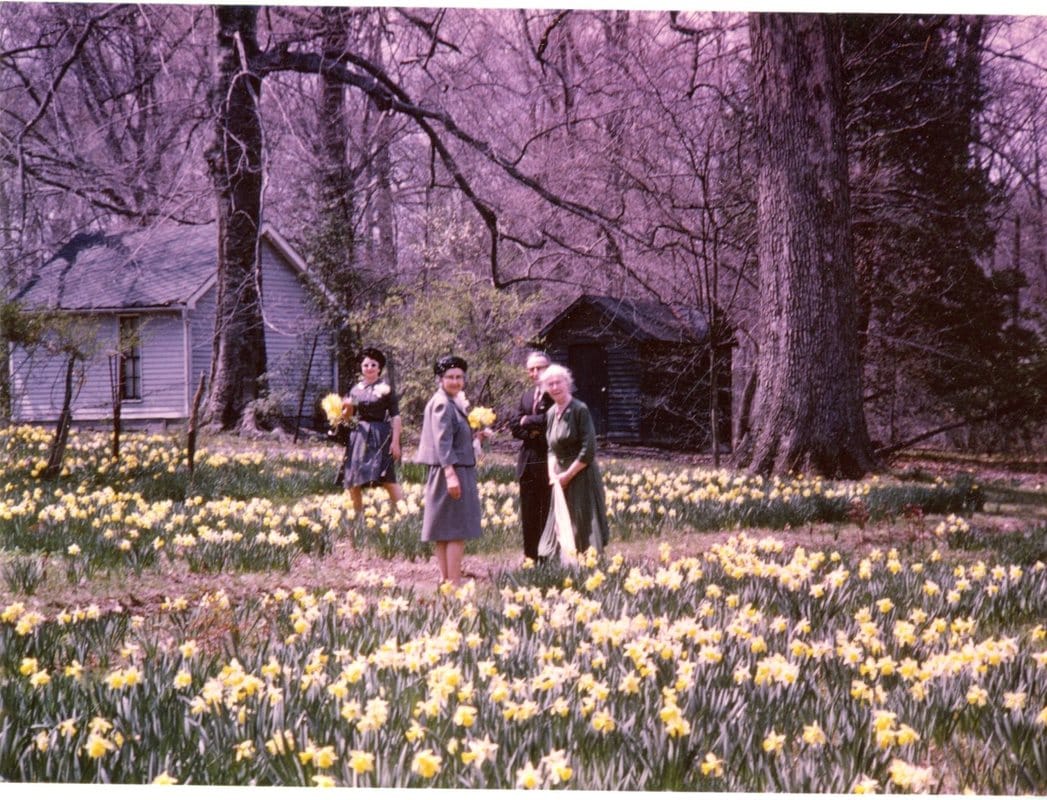 Above and below, Mary Johnston amidst her rows of daffodils at The Beeches ca. 1962. From the Norris Summers collection, courtesy Bethany Major.
Above and below, Mary Johnston amidst her rows of daffodils at The Beeches ca. 1962. From the Norris Summers collection, courtesy Bethany Major.
Primroses were a later garden staple. Cissy Gregg, Home Correspondent, wrote the story of Mary's primroses for the April 27, 1952 Courier-Journal:
This is a story which should encourage all flower lovers who can't resist planting a package of seed.
A number of years ago -- maybe 10, maybe longer -- Miss Mary Johnston, Pewee Valley, ordered a package of seed for English primroses. Since the primrose is one of her favorite flowers, she planted the seed with loving care.
It was disheartening to find that only one plant came up from the package of seed. But that one plant has done well by her.
There in the wildflower garden at The Beeches, it has scattered seeds during the intervening years until a large patch is literally covered in bright yellow primroses.
They have even gone visiting, and even to live, in other beds close by ...
... Miss Johnston likes to get down on her knees to them and bury her face in their massed bloom. There she can store up good memories of their delicate fragrance to remember them by after they have stopped blooming...
This is a story which should encourage all flower lovers who can't resist planting a package of seed.
A number of years ago -- maybe 10, maybe longer -- Miss Mary Johnston, Pewee Valley, ordered a package of seed for English primroses. Since the primrose is one of her favorite flowers, she planted the seed with loving care.
It was disheartening to find that only one plant came up from the package of seed. But that one plant has done well by her.
There in the wildflower garden at The Beeches, it has scattered seeds during the intervening years until a large patch is literally covered in bright yellow primroses.
They have even gone visiting, and even to live, in other beds close by ...
... Miss Johnston likes to get down on her knees to them and bury her face in their massed bloom. There she can store up good memories of their delicate fragrance to remember them by after they have stopped blooming...
Relics from The Beeches and Annie Fellows Johnston Displayed at the Pewee Valley Museum in conjunction with the 2017 State Historical Marker Dedication
Related Links:

